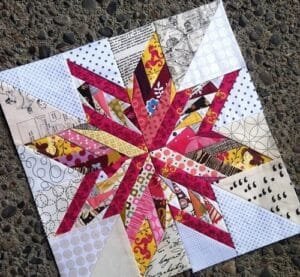Welcome to the Whimsical Bicycle Art Quilt – Tutorial, where we guide you through the process of creating a fun and creative art quilt featuring a charming bicycle design.
This project is perfect for quilters who want to explore their artistic side while adding a whimsical touch to their work. The Whimsical Bicycle Art Quilt blends traditional quilting techniques with appliqué, allowing you to create a quilt that truly stands out.
Whether you’re looking to make a unique wall hanging or a one-of-a-kind gift, this tutorial will give you everything you need to know to bring your vision to life.

In this tutorial, we’ll cover everything from choosing fabrics to the final touches, ensuring your quilt looks polished and professional.
The Whimsical Bicycle Art Quilt allows for plenty of creative freedom. Feel free to play around with fabric patterns, colors, and embellishments to make it truly your own.
It’s a great way to use up your fabric scraps while practicing techniques like free-motion quilting and appliqué.
Before diving into the detailed steps of creating your quilt, be sure to gather your materials and set up a workspace conducive to creativity.
A well-organized space will make it easier to enjoy the process and prevent frustration. Now, let’s get started on making your Whimsical Bicycle Art Quilt a reality!
1. Materials Needed for the Whimsical Bicycle Art Quilt
Gathering the right materials is the first step in creating your Whimsical Bicycle Art Quilt. Here’s what you’ll need to get started:
- Fabric: Choose fabrics that will bring your bicycle design to life. You can use a solid background fabric, and pick playful patterns for the bicycle frame, wheels, and accents. Consider using fabric scraps for the smaller appliqué pieces.
- Fusible Web: A fusible web will be essential for attaching your appliqué pieces to the background fabric. This will ensure they stay in place while you sew them down.
- Sewing Machine and Needles: Use a sewing machine for piecing the quilt together and appliqué work. Make sure your machine is fitted with a sharp needle suitable for quilting.
- Thread: Pick thread colors that complement your fabric choices. You may want to use contrasting thread for decorative stitching or matching thread for a more subtle look.
- Rotary Cutter and Cutting Mat: These tools will help you cut your fabric pieces with precision. Having a sharp rotary cutter is key to getting clean edges on your appliqué pieces.
- Batting and Backing Fabric: You will need batting to give your quilt some body and backing fabric to finish it off. Choose a lightweight batting for an art quilt and a fabric for the back that complements the front design.
Once you have your materials assembled, you’re ready to start cutting and preparing your fabric pieces for the whimsical bicycle design.
2. Preparing and Cutting Fabric for the Whimsical Bicycle Art Quilt
Now that you have all your materials, it’s time to prepare and cut your fabric for the Whimsical Bicycle Art Quilt – Tutorial. This step ensures that all your appliqué pieces are ready to be assembled.
- Choose the Background Fabric: Start by selecting a background fabric for your quilt. This will serve as the canvas for your bicycle design. Cut your background fabric to the desired quilt size—typically around 24 x 36 inches for a wall hanging.
- Sketch the Bicycle Design: Before cutting your fabric, it’s helpful to sketch out your bicycle design on paper. This will give you a visual reference and help you determine the sizes of each appliqué piece.
- Cut the Bicycle Frame Pieces: Using your sketch as a guide, cut out the pieces for the bicycle frame from your fabric. Use contrasting colors to make the bicycle stand out against the background. Be sure to add seam allowances where necessary.
- Prepare the Wheels: For the bicycle wheels, cut two circles from your chosen fabric. You can either use a template or freehand the circles, depending on the look you’re going for. Add spokes and other details as desired.
- Cutting Additional Appliqué Pieces: Once the main bicycle pieces are cut, you can move on to additional appliqué details, such as the seat, handlebars, and basket. Use playful fabrics for these smaller pieces to enhance the whimsical nature of the quilt.
- Apply Fusible Web: To prepare your appliqué pieces for sewing, apply fusible web to the back of each one. This will allow you to iron them onto the background fabric, holding them in place while you stitch them down.
With all your pieces cut and prepared, you’re ready to begin assembling your quilt top and adding the whimsical bicycle design.
3. Assembling the Whimsical Bicycle Art Quilt
Now that your fabric pieces are cut, it’s time to assemble your Whimsical Bicycle Art Quilt. This part of the process brings your bicycle design to life.
- Layout Your Appliqué Pieces: Begin by laying out all your appliqué pieces on the background fabric. Arrange them according to your sketch, making sure everything is positioned where you want it before you begin ironing and sewing.
- Iron the Appliqué Pieces: Once you’re satisfied with the layout, use your iron to adhere the appliqué pieces to the background fabric. The fusible web will secure the pieces temporarily, making it easier to sew them down without shifting.
- Stitching the Appliqué: With the appliqué pieces in place, it’s time to sew them down. Use a straight stitch, zigzag stitch, or satin stitch around the edges of each piece. If you want to add more dimension, consider using free-motion quilting techniques for additional decorative stitching.
- Adding Embellishments: Now is the time to add any embellishments to your quilt. You can use buttons for the bicycle wheels, embroidery for the spokes, or even fabric flowers for the basket. These little touches will add character to your quilt.
- Assembling the Quilt Layers: Once the appliqué work is complete, it’s time to layer your quilt. Place the batting between the quilt top and backing fabric, making sure everything is smooth and aligned.
- Quilting the Layers: Quilt the three layers together using either free-motion quilting or straight lines. You can choose to follow the contours of your bicycle design or create a pattern that complements the quilt’s overall look.
4. Finishing Your Whimsical Bicycle Art Quilt
With the quilt top assembled and quilted, the final step in the Whimsical Bicycle Art Quilt – Tutorial is finishing the edges and adding any last details.
- Trimming the Edges: After quilting, trim any excess batting and backing fabric to align with the edges of the quilt top. This will ensure that the edges are clean and ready for binding.
- Binding the Quilt: Cut strips of fabric for the binding, fold them in half lengthwise, and sew them around the edge of the quilt. This will give your quilt a polished finish and protect the raw edges from fraying over time.
- Label Your Quilt: If this quilt is a gift or part of a collection, consider adding a label to the back. You can write your name, the date, and any other details you’d like to remember or share.
- Final Pressing: Give your quilt a final pressing to smooth out any wrinkles and make the design pop. A well-pressed quilt always looks more professional.
- Hanging Loops (Optional): If you’re planning to hang your quilt as art, you can sew small fabric loops along the top edge. This will make it easy to display on a wall.
- Enjoying Your Quilt: With your quilt finished, take a moment to admire your work. The Whimsical Bicycle Art Quilt is now complete and ready to be displayed, gifted, or enjoyed for years to come.
FAQ About the Whimsical Bicycle Art Quilt – Tutorial
Q1: What size should the Whimsical Bicycle Art Quilt be?
The size of the quilt can vary depending on your preference, but a common size for an art quilt is 24 x 36 inches. Adjust the size according to your space or project needs.
Q2: Can I use fabric scraps for the appliqué?
Yes! This project is perfect for using up fabric scraps. The whimsical nature of the design means you can mix and match different patterns and colors to create a unique look.
Q3: Do I need a special sewing machine for this project?
No, a standard sewing machine will work just fine. If you have a machine with free-motion quilting capabilities, that can add more flexibility for decorative stitching.
Q4: What type of batting should I use?
For an art quilt, a lightweight batting works best. You can use cotton, polyester, or a blend, depending on your preference. A thin batting will give your quilt a smooth finish without adding too much bulk.
Q5: How can I personalize my quilt design?
You can personalize your quilt by choosing fabrics that reflect your style, adding embellishments like buttons or embroidery, or even changing the color scheme to match your home décor.
Q6: How do I display my Whimsical Bicycle Art Quilt?
You can display your quilt by adding hanging loops or a sleeve to the back, or you can frame it for a more formal presentation. It makes a beautiful piece of wall art!
Join our VIP broadcast list and gain access to exclusive patterns, all for free. As a VIP member, you’ll receive the best patterns daily, delivered directly to your device. ✨📱 It’s a unique opportunity to stay up-to-date with the latest trends and designs, curated just for you. Don’t miss out on enhancing your projects and discovering new inspirations with the best patterns every day! 🎨🔝
Conclusion
In this Whimsical Bicycle Art Quilt – Tutorial, we’ve covered all the steps to create a unique and playful quilt that’s sure to be a conversation starter. From gathering your materials and cutting fabric to adding appliqué and finishing touches, this project encourages creativity and experimentation.
Now it’s your turn to dive into the world of art quilting and make your own whimsical masterpiece. We’d love to hear your thoughts—please leave a comment below with your suggestions, feedback, or questions!



